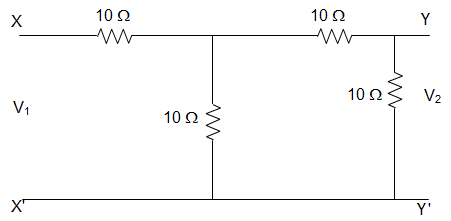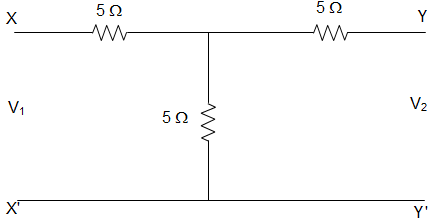This set of Network Theory Multiple Choice Questions & Answers (MCQs) focuses on “Hybrid (h) Parameter”.
1. For the circuit given below, the value of the hybrid parameter h11 is ___________

a) 15 Ω
b) 20 Ω
c) 30 Ω
d) 25 Ω
View Answer
Explanation: Hybrid parameter h11 is given by, h11 = \(\frac{V_1}{I_1}\), when V2=0.
Therefore short circuiting the terminal Y-Y’, we get,
V1 = I1 ((10||10) + 10)
= I1 \(\left(\left(\frac{10×10}{10+10}\right)+10\right)\)
= 15I1
∴ \(\frac{V_1}{I_1}\) = 15.
Hence h11 = 15 Ω.
2. For the circuit given below, the value of the hybrid parameter h21 is ___________

a) 0.6 Ω
b) 0.5 Ω
c) 0.3 Ω
d) 0.2 Ω
View Answer
Explanation: Hybrid parameter h21 is given by, h21 = \(\frac{I_2}{I_1}\), when V2=0.
Therefore short circuiting the terminal Y-Y’, and applying Kirchhoff’s law, we get,
-10 I2 – (I2 – I1)10 = 0
Or, -I2 = I2 – I1
Or, -2I2 = -I1
∴ \(\frac{I_2}{I_1} = \frac{1}{2}\)
Hence h21 = 0.5 Ω.
3. For the circuit given below, the value of the hybrid parameter h12 is ___________

a) 6 Ω
b) 5 Ω
c) 1 Ω
d) 2 Ω
View Answer
Explanation: Hybrid parameter h12 is given by, h12 = \(\frac{V_1}{V_2}\), when I1 = 0.
Therefore short circuiting the terminal X-X’ we get,
V1 = IA × 10
IA = \(\frac{I_2}{2}\)
V2 = IB × 10
IB = \(\frac{I_2}{2}\)
From the above 4 equations, we get,
∴ \(\frac{V_1}{V_2} = \frac{I_2×10}{I_2×10}\) = 1
Hence h12 = 1 Ω.
4. For the circuit given below, the value of the hybrid parameter h22 is ___________

a) 0.2 Ω
b) 0.5 Ω
c) 0.1 Ω
d) 0.3 Ω
View Answer
Explanation: Hybrid parameter h22 is given by, h22 = \(\frac{I_2}{V_2}\), when I1 = 0.
Therefore short circuiting the terminal X-X’ we get,
V1 = IA × 10
IA = \(\frac{I_2}{2}\)
V2 = IB × 10
IB = \(\frac{I_2}{2}\)
From the above 4 equations, we get,
∴ \(\frac{I_2}{V_2} = \frac{I_2×2}{I_2×10}\) = 0.2
Hence h22 = 0.2 Ω.
5. In the circuit given below, the value of the hybrid parameter h11 is _________

a) 10 Ω
b) 7.5 Ω
c) 5 Ω
d) 2.5 Ω
View Answer
Explanation: Hybrid parameter h11 is given by, h11 = \(\frac{V_1}{I_1}\), when V2 = 0.
Therefore short circuiting the terminal Y-Y’, we get,
V1 = I1 ((5 || 5) + 5)
= I1 \(\left(\left(\frac{5×5}{5+5}\right)+5\right)\)
= 7.5I1
∴ \(\frac{V_1}{I_1}\) = 7.5
Hence h11 = 7.5 Ω.
6. In the circuit given below, the value of the hybrid parameter h21 is _________

a) 10 Ω
b) 0.5 Ω
c) 5 Ω
d) 2.5 Ω
View Answer
Explanation: Hybrid parameter h21 is given by, h21 = \(\frac{I_2}{I_1}\), when V2 = 0.
Therefore short circuiting the terminal Y-Y’, and applying Kirchhoff’s law, we get,
-5 I2 – (I2 – I1)5 = 0
Or, -I2 = I2 – I1
Or, -2I2 = -I1
∴ \(\frac{I_2}{I_1} = \frac{1}{2}\)
Hence h21 = 0.5 Ω.
7. For the circuit given below, the value of the hybrid parameter h12 is ___________

a) 6 Ω
b) 5 Ω
c) 1 Ω
d) 2 Ω
View Answer
Explanation: Hybrid parameter h12 is given by, h12 = \(\frac{V_1}{V_2}\), when I1 = 0.
Therefore short circuiting the terminal X-X’ we get,
V1 = IA × 5
V2 = IA × 5
From the above equations, we get,
∴ \(\frac{V_1}{V_2} = \frac{I_A×10}{I_A×10}\) = 1
Hence h12 = 1 Ω.
8. For the circuit given below, the value of the hybrid parameter h22 is ___________

a) 0.2 Ω
b) 0.5 Ω
c) 0.1 Ω
d) 0.3 Ω
View Answer
Explanation: Hybrid parameter h22 is given by, h22 = \(\frac{I_2}{V_2}\), when I1 = 0.
Therefore short circuiting the terminal X-X’ we get,
V1 = IA × 5
V2 = IA × 5
IA = I2
From the above equations, we get,
∴ \(\frac{I_2}{V_2} = \frac{I_2}{I_2×5}\) = 0.2
Hence h22 = 0.2 Ω.
9. In two-port networks the parameter h11 is called _________
a) Short circuit input impedance
b) Short circuit current gain
c) Open circuit reverse voltage gain
d) Open circuit output admittance
View Answer
Explanation: We know that, h11 = \(\frac{V_1}{I_1}\), when V2 = 0.
Since the second output terminal is short circuited when the ratio of the two voltages is measured, therefore the parameter h11 is called as Short circuit input impedance.
10. In two-port networks the parameter h21 is called _________
a) Short circuit input impedance
b) Short circuit current gain
c) Open circuit reverse voltage gain
d) Open circuit output admittance
View Answer
Explanation: We know that, h21 = \(\frac{I_2}{I_1}\), when V2 = 0.
Since the second output terminal is short circuited when the ratio of the two currents is measured, therefore the parameter h21 is called Short circuit current gain.
11. In two-port networks the parameter h12 is called _________
a) Short circuit input impedance
b) Short circuit current gain
c) Open circuit reverse voltage gain
d) Open circuit output admittance
View Answer
Explanation: We know that, h21 = \(\frac{V_1}{V_2}\), when I1 = 0.
Since the current in the first loop is 0 when the ratio of the two voltages is measured, therefore the parameter h12 is called as Open circuit reverse voltage gain.
12. In two-port networks the parameter h22 is called _________
a) Short circuit input impedance
b) Short circuit current gain
c) Open circuit reverse voltage gain
d) Open circuit output admittance
View Answer
Explanation: We know that, h22 = \(\frac{I_2}{V_2}\), when I1 = 0.
Since the current in the first loop is 0 when the ratio of the current and voltage in the second loop is measured, therefore the parameter h22 is called as Open circuit output admittance.
13. For a T-network if the Short circuit admittance parameters are given as y11, y21, y12, y22, then y11 in terms of Hybrid parameters can be expressed as ________
a) y11 = \(\left(- \frac{h_{21} h_{12}}{h_{11}} + h_{22}\right)\)
b) y11 = \(\frac{h_{21}}{h_{11}}\)
c) y11 = –\(\frac{h_{12}}{h_{11}}\)
d) y11 = \(\frac{1}{h_{11}} \)
View Answer
Explanation: We know that the short circuit admittance parameters can be expressed in terms of voltages and currents as,
I1 = y11 V1 + y12 V2 ……… (1)
I2 = y21 V1 + y22 V2 ………. (2)
And the Hybrid parameters can be expressed in terms of voltages and currents as,
V1 = h11 I1 + h12 V2 ………. (3)
I2 = h21 I1 + h22 V2 ……….. (4)
Now, (3) and (4) can be rewritten as,
I1 = \(\frac{V_1}{h_{11}} – \frac{h_{12} V_2}{h_{11}}\) ………. (5)
And I2 = \(\frac{h_{21} V_1}{h_{11}} + \left(- \frac{h_{21} h_{12}}{h_{11}} + h_{22}\right) V_2\) ………. (6)
∴ Comparing (1), (2) and (5), (6), we get,
y11 = \(\frac{1}{h_{11}} \)
y12 = –\(\frac{h_{12}}{h_{11}}\)
y21 = \(\frac{h_{21}}{h_{11}}\)
y22 = \(\left(- \frac{h_{21} h_{12}}{h_{11}} + h_{22}\right)\).
14. For a T-network if the Short circuit admittance parameters are given as y11, y21, y12, y22, then y12 in terms of Hybrid parameters can be expressed as ________
a) y12 = \(\left(- \frac{h_{21} h_{12}}{h_{11}} + h_{22}\right)\)
b) y12 = \(\frac{h_{21}}{h_{11}}\)
c) y12 = –\(\frac{h_{12}}{h_{11}}\)
d) y12 = \(\frac{1}{h_{11}} \)
View Answer
Explanation: We know that the short circuit admittance parameters can be expressed in terms of voltages and currents as,
I1 = y11 V1 + y12 V2 ……… (1)
I2 = y21 V1 + y22 V2 ………. (2)
And the Hybrid parameters can be expressed in terms of voltages and currents as,
V1 = h11 I1 + h12 V2 ………. (3)
I2 = h21 I1 + h22 V2 ……….. (4)
Now, (3) and (4) can be rewritten as,
I1 = \(\frac{V_1}{h_{11}} – \frac{h_{12} V_2}{h_{11}}\) ………. (5)
And I2 = \(\frac{h_{21} V_1}{h_{11}} + \left(- \frac{h_{21} h_{12}}{h_{11}} + h_{22}\right) V_2\) ………. (6)
∴ Comparing (1), (2) and (5), (6), we get,
y11 = \(\frac{1}{h_{11}} \)
y12 = –\(\frac{h_{12}}{h_{11}}\)
y21 = \(\frac{h_{21}}{h_{11}}\)
y22 = \(\left(- \frac{h_{21} h_{12}}{h_{11}} + h_{22}\right)\).
15. For a T-network if the Short circuit admittance parameters are given as y11, y21, y12, y22, then y22 in terms of Hybrid parameters can be expressed as ________
a) y22 = \(\left(- \frac{h_{21} h_{12}}{h_{11}} + h_{22}\right)\)
b) y22 = \(\frac{h_{21}}{h_{11}}\)
c) y22 = –\(\frac{h_{12}}{h_{11}}\)
d) y22 = \(\frac{1}{h_{11}} \)
View Answer
Explanation: We know that the short circuit admittance parameters can be expressed in terms of voltages and currents as,
I1 = y11 V1 + y12 V2 ……… (1)
I2 = y21 V1 + y22 V2 ………. (2)
And the Hybrid parameters can be expressed in terms of voltages and currents as,
V1 = h11 I1 + h12 V2 ………. (3)
I2 = h21 I1 + h22 V2 ……….. (4)
Now, (3) and (4) can be rewritten as,
I1 = \(\frac{V_1}{h_{11}} – \frac{h_{12} V_2}{h_{11}}\) ………. (5)
And I2 = \(\frac{h_{21} V_1}{h_{11}} + \left(- \frac{h_{21} h_{12}}{h_{11}} + h_{22}\right) V_2\) ………. (6)
∴ Comparing (1), (2) and (5), (6), we get,
y11 = \(\frac{1}{h_{11}} \)
y12 = –\(\frac{h_{12}}{h_{11}}\)
y21 = \(\frac{h_{21}}{h_{11}}\)
y22 = \(\left(- \frac{h_{21} h_{12}}{h_{11}} + h_{22}\right)\).
Sanfoundry Global Education & Learning Series – Network Theory.
To practice all areas of Network Theory, here is complete set of 1000+ Multiple Choice Questions and Answers.
If you find a mistake in question / option / answer, kindly take a screenshot and email to [email protected]
- Practice Electrical Engineering MCQs
- Apply for Electrical Engineering Internship
- Check Electronics & Communication Engineering Books
- Check Electrical Engineering Books
- Check Network Theory Books
